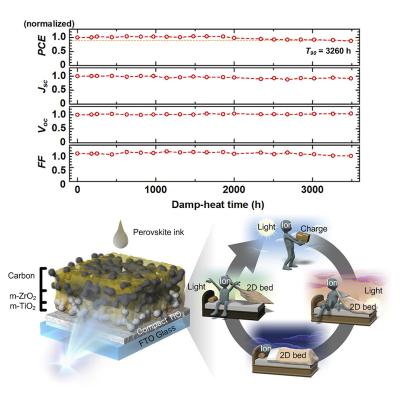Scientists from Japan's Kishu Giken Kogyo and University of Hyogo, Switzerland's Solaronix and Germany's Fraunhofer ISE have examined the long-term stability of perovskite solar cells using layers of mesoporous carbon, building on previous work that showed the strong potential of this approach.
Schematics of reversible light-induced performance increase for m-CPSM. Image from study
This recent work demonstrated a light-soaking effect, which allowed them to fabricate cells that retained 92% of their initial performance after 3,000 hours in damp heat conditions – which the researchers say is equivalent to 20 years in the field.
A 2017 study carried out by École polytechnique fédérale de Lausanne (EPFL) found that m-CPSMs could be stable for more than 10,000 hours under ‘one sun’ illumination. This study also noted an initial increase in the cells’ efficiency under illumination – and another group of researchers led by Japan’s University of Hyogo set out to understand the mechanisms behind this, and how it might affect cells in outdoor, day and night conditions, rather than under constant illumination.
The group in this recent work was able to fabricate cells that stood up to 3,000 hours of damp heat testing – at 85 degrees Celsius and 85% humidity – and retained 92% of their initial performance. The cells still retained 90% of their initial performance after 3,260 hours, which the group calculates is equivalent to 20 years installed in outdoor conditions.
The cells’ impressive stability was attributed to a reversible light-induced performance increase, involving a reaction between methylammonium – a major component of the perovskite layer, and another organic additive to the materials known as 5-AVAI (5-ammoniumvaleric acid iodide), which was shown to improve charge transport and ion migration in the material.
This increased the efficiency by 1.4% (absolute) within 10 minutes, and led to a relative increase of 16% after 100 hours illumination. The effect is also shown to be reversible, with the cell returning to its initial efficiency when stored in the dark, and increasing again even when placed under low-light conditions.
The group further noted that it used ‘industry compatible’ processes to produce the cells, and expected the light soaking effect to apply similarly to large-scale devices. “This gain should be taken into account for market value and the design architecture of the system used in the devices,†they state. “In addition, the LS techniques presented can allow accurate evaluation and stable operation as well as increased performance, so that these findings will lead to research directed toward practical application of perovskite PVs.â€




